Are you wondering about the key differences between scuppernongs and muscadines? If so, you’re in luck.
In this article, we’ll provide a helpful breakdown of both varieties—from their climates to their sizes.
So keep reading to find out more.

What is Scuppernong?
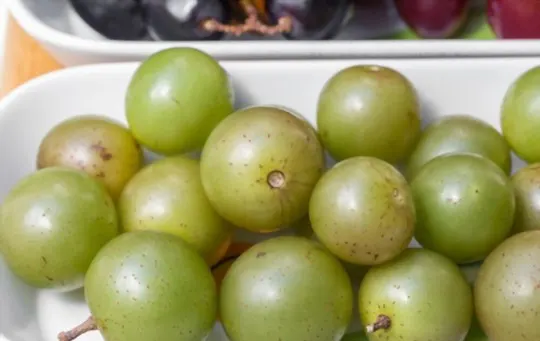
Scuppernong is a type of grape that is native to the southeastern United States.
It is also known as the “big white grape” due to its large size and light green to bronze color when ripe.
This grape variety was first discovered in North Carolina and is often associated with Southern cuisine and culture.
As a reader, if you are looking for information about Scuppernong grapes, then you have come to the right place.
Scuppernong grapes are unique because they are one of the few grape varieties that are native to the United States.
Their sweet and musky taste makes them an excellent addition to numerous dishes.
In terms of their growing season, Scuppernongs typically ripen in late summer or early fall.
They can be consumed fresh or used in making jams, jellies, or wine.
Whether you are a professional chef or someone who enjoys trying new foods, Scuppernongs may be an interesting fruit to experiment with.
What is Muscadine?
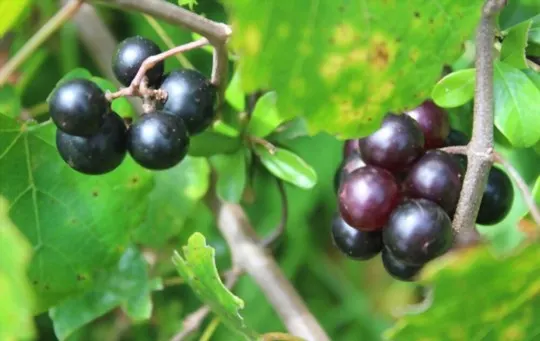
Muscadine is another type of grape that is very similar to Scuppernong.
These large, round berries are native to the southeastern United States, just like Scuppernongs, and are commonly used for making jams, jellies, wine, and more.
Like Scuppernongs, Muscadines grow in large clusters on woody vines that can reach up to 80 feet in length.
They also have tough skins that protect them from pests and disease.
Despite their similarities, there are some noticeable differences between Scuppernongs and Muscadines.
We will explore these differences in more detail in the next section.
Differences Between Scuppernongs and Muscadines
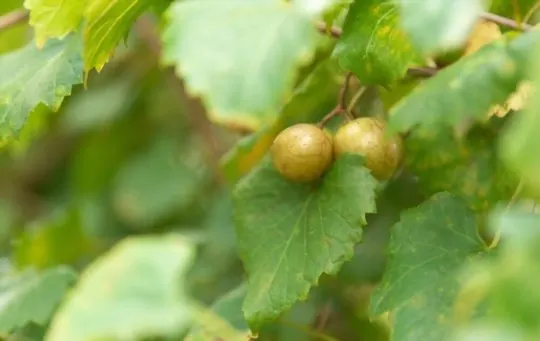
Scuppernongs and muscadines are two types of grapes that belong to the Vitis rotundifolia family.
Although they are closely related, there are some significant differences between them in terms of taste, texture, color, and usage.
Scuppernongs are typically found in North Carolina, South Carolina, Georgia and Florida while Muscadines can be found from Southern Virginia down the east coast to Florida and westward to Texas.
The main difference in their appearance is their color – scuppernongs are generally a greenish-yellow or golden-bronze while muscadines are usually purple or black when fully ripe.
When it comes to taste profile, both grapes have their own unique flavors.
Scuppernongs have a mild fruity tanginess while muscadines have a stronger combination of natural sweetness combined with tartness.
In terms of usage, Scuppernongs are preferred for fresh eating, wine-making and preserves because of their lower sugar content relative to Muscadines which makes them great for use in savory dishes like pork chops but also suitable for sweet desert applications.
Muscadines on the other hand are excellent for fresh eating as well as juice making because of its relatively high juice yield due to thin skin and high sugar content.
Appearance
When it comes to the appearance of scuppernongs and muscadines, there are a few key differences.
To start with, scuppernongs tend to be slightly larger than muscadines, with an average size of about one inch in diameter compared to muscadines’ average size of just under an inch.
Additionally, scuppernongs are greenish-gold in color when ripe, while muscadines range from deep purple to bronze.
As you can see from the table above, there are distinct variances between the two types of grapes concerning size and color when looking at overall appearance.
In terms of texture, both scuppernongs and muscadines have thick skins with a pulpy interior filled with seeds.
However, scuppernongs tend to have more tender skin than muscadines.
Overall in terms of appearance, while both varieties originate from the same species – Vitis rotundifolia- which is native to the Southeastern United States; they have different physical features that make them easily distinguishable from each other.
Taste and Flavor Profile
The taste and flavor profile of scuppernong and muscadine grapes is what sets them apart.
Scuppernongs are known for their sweeter taste, whereas muscadines have a more complex flavor with a hint of tartness.
Scuppernongs possess a distinct honey-like sweetness, which makes them perfect for making jams or jellies, as well as snacks or desserts.
On the other hand, muscadines offer a more unique experience with its bold and earthy flavors.
They can be eaten fresh or used in making wine due to their higher acidity.
If you prefer sweeter flavors and floral notes, then scuppernongs are your go-to grape.
If an intense depth of flavor intrigues you, then you might want to try muscadines.
Nutritional Value
The following section will focus on the nutritional value of scuppernong and muscadine grapes.
These two varieties of grapes are both popular in the southeastern part of the United States, and they have unique nutritional benefits.
Both scuppernongs and muscadines are low in calories and fat but high in carbohydrates.
Interestingly, muscadines have a slightly higher protein content than scuppernongs.
Both fruits also provide fiber and some essential vitamins and minerals like vitamin C and calcium.
While not as nutrient-dense as other fruits such as berries or citrus fruits, scuppernongs and muscadines offer health benefits unique to their composition.
For example, they contain phenolic compounds that can act as antioxidants, which may help protect against certain diseases like cancer.
Cultivation and Growing Conditions
Grapes are an ancient fruit that has been cultivated for thousands of years.
The scuppernong and the muscadine are both types of grapes commonly grown in the southern United States.
Both scuppernongs and muscadines grow well in warm climates with plenty of sunshine.
They thrive in regions with long, hot summers and mild winters.
Here are a few tips for growing these delicious grapes.
- Soil: Grapes prefer well-drained soil rich in organic matter.
- Watering: Young grapevines need regular watering until they are established. Once mature, grapevines can tolerate dry conditions.
- Pruning: Grapevines need regular pruning to remove old wood and promote new growth.
- Disease Management: Both scuppernongs and muscadines are susceptible to fungal diseases. Using fungicides, proper pruning techniques, or genetic resistance can help prevent infection.
While scuppernongs grow best as vineyard plants, muscadines can be grown using various trellising systems such as gable, single wire with stakes umbrella, divided canopy, etc.
Vines will spread up to 20 feet wide so growers need ample room with plenty of support structures for the vines.
After harvesting, grapes should be stored at cool temperatures (32 – 40°F) for long term storage.
Grapes can be kept fresh in cold storage for over a month.
However, frozen grapes will last indefinitely and can be used to make concentrated juice or jams.
Similarities Between Scuppernongs and Muscadines
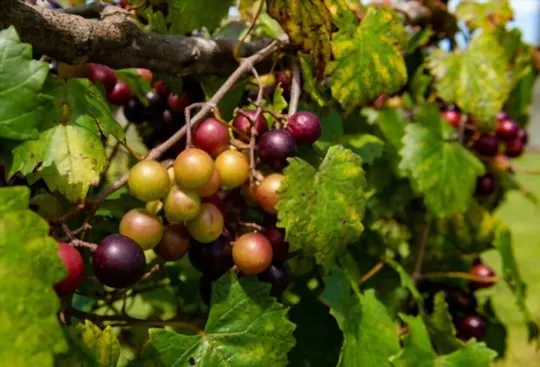
Scuppernongs and muscadines share a lot in common when it comes to their physical features.
Both varieties are classified as a type of grape and belong to the same family, Vitaceae.
They are also native to North America and grow predominantly in the southeastern United States.
Overall, scuppernongs and muscadines have more similarities than differences.
They are equally healthy fruits that can be enjoyed fresh or turned into wine or jelly.
It’s worth noting that both grapes have tough outer skins that are commonly discarded before consumption.
This fibrous layer helps protect the juicy pulp inside from disease-carrying pests.
In terms of growth habits, both scuppernongs and muscadines prefer hot summers with plenty of sunshine for optimal growth.
They can also withstand brief periods of drought but require well-draining soil to prevent root rot.
If you’re considering growing these grapes at home, keep in mind that they both require regular pruning to promote better fruit production.
Consult with your local horticulturalist for specific growing instructions based on your region.
Popular Uses and Recipes for Scuppernongs and Muscadines
Scuppernongs and muscadines are widely known for their unique taste and health benefits.
They are commonly used in various recipes, ranging from pies to jams, and even wines.
The juice of both fruits is a popular thirst-quencher, whether consumed directly or as an ingredient in drinks.
Muscadine juice is commonly mixed with other fruit juices like cranberry juice.
For those who prefer a sweeter taste, adding sugar to taste will be handy.
Meanwhile, a flavorful scuppernong pie can be made by simply adding spices like cinnamon to the seedless pulp mixture before baking in the oven.
In addition to making jams and jellies with scuppernongs and muscadines, they can be used in salsa.
A generous serving of finely chopped scuppernongs and muscadine mixed with tomatoes, jalapenos, onions, and spices will make for a naturally sweet and spicy dip.
Adding more flavors comes by pairing foods with different Tastes.
Lastly, scuppernong jelly beans or muscadine flavored jelly beans are fantastic ways to experience the taste of these fruits without having to eat them raw.
The fruit’s natural sweetness is perfect for flavoring confectionery items like candy and gum; the combination is delightful.
Where to Buy Scuppernongs and Muscadines?
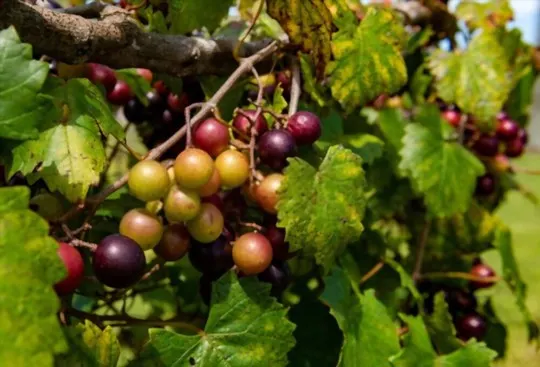
Answering the question of ‘Where to Buy Scuppernongs and Muscadines?’, there are various options available for purchasing these fruits.
One can buy them from local farmer’s markets, grocery stores, online retailers, or directly from farms that specialize in growing these varieties.
Local farmer’s markets are a great place to buy Scuppernongs and Muscadines if one wants to ensure freshness and support local farmers.
These markets generally have a wide variety of fresh produce options along with unique locally grown fruits like Scuppernongs and Muscadines.
Grocery stores also offer Scuppernongs and Muscadines in their produce section during their respective seasons.
However, these may not always be as fresh as those bought from local farmers’ markets or farms.
For those who prefer the convenience of online shopping, several eCommerce websites offer fresh fruit delivery services.
This is particularly useful for those living in areas where they might not have access to these fruits locally.
Last but not least, buying directly from farms which specialize in growing these varieties would give them a better understanding of how the fruits were produced, harvested and treated before being made available for sale.
Conclusion
As we have discussed in this article, scuppernong and muscadine are two types of grapes that are native to the southeastern United States.
While they are similar in many ways, there are a few key differences between them that set them apart.
Ultimately, whether you prefer scuppernong or muscadine grapes comes down to personal preference.
Both varieties have their own unique qualities and can be enjoyed in a variety of different ways.
So why not try them both and decide for yourself which one you like best?
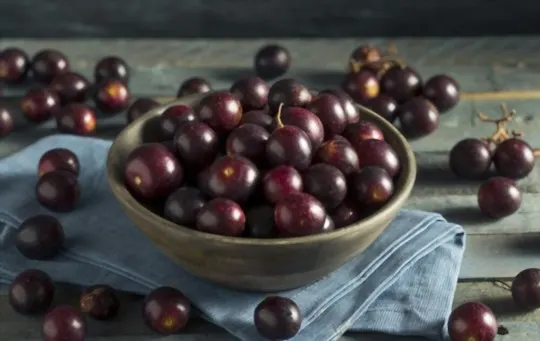
Scuppernong vs Muscadine: What’s the Difference?
Ingredients
- Scuppernong
- Muscadine
Instructions
- Choose between two items based on your preference and availability.
- Follow the cooking directions for your chosen option, using the appropriate ratio of ingredients.
- Prepare it according to your desired recipes.
- Incorporate them into your dish, adjusting the amount to suit your taste.
- Enjoy the unique taste experience and experiment with different dishes to explore their versatility.

Andrew Gray is a seasoned food writer and blogger with a wealth of experience in the restaurant and catering industries. With a passion for all things delicious, Andrew has honed his culinary expertise through his work as a personal chef and caterer.
His love for food led him to venture into food writing, where he has contributed to various online publications, sharing his knowledge and insights on the culinary world. As the proud owner of AmericasRestaurant.com, Andrew covers a wide range of topics, including recipes, restaurant reviews, product recommendations, and culinary tips.
Through his website, he aims to inspire and educate fellow food enthusiasts, offering a comprehensive resource for all things food-related.

Leave a comment